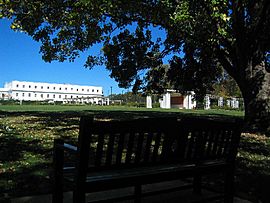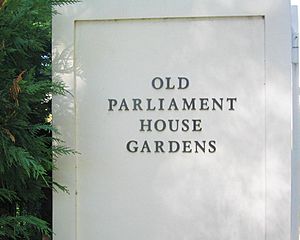National Rose Garden facts for kids
Quick facts for kids National Rose Garden |
|
|---|---|

The Old Parliament House Gardens
|
|
| Type | Rose garden |
| Location | King George Tce, Parkes, Canberra, Australian Capital Territory, Australia |
| Area | approx. 4.5 hectares (11 acres) |
| Established | 12 September 1933 by John Perkins, Minister for the Interior |
| Designer | Thomas Weston |
| Administered by | National Capital Authority |
| Official name: National Rose Gardens, King George Tce, Parkes, ACT, Australia | |
| Type: | Listed place |
| Criteria: | A., B., E. |
| Designated: | 22 June 2004 |
| Reference #: | 105473 |
The National Rose Gardens are beautiful rose gardens in Canberra, Australia's capital city. They are located in a suburb called Parkes. These gardens are very special because they are listed on the Commonwealth Heritage List. This means they are an important part of Australia's history and culture. They were added to this list on June 22, 2004.
The idea for the National Rose Gardens started in 1926. They officially opened in 1933. This was Australia's first big national gardening project. The gardens were meant to show how different parts of Australia could work together. All the States in Australia helped by giving roses.
The gardens were also designed to make Canberra a "garden city." They show a unique style of public garden design from the early 1900s. The climate in Canberra is great for growing roses. This allows the gardens to display many beautiful Australian and international roses. The gardens are right in front of the Old Parliament House. This makes the area look even more impressive. Many people, both visitors and locals, love the gardens for their beauty.
Contents
A Brief History of the Rose Gardens
The idea for an Australian Rose Garden in Canberra began in 1926. It was suggested by the National Rose Society of NSW. Plans for the gardens were ready by 1932. Rose societies in each Australian State were asked to donate roses.
Each garden was planned to have 2,000 standard and climbing roses. The flower beds were designed to have different types of roses arranged by colour. Many public groups and private people gave roses. The first rose was planted on September 12, 1933. This was done by John Perkins, who was a government minister. The rose was called 'Daily Mail' and was given by Victorian Mothers' Clubs.
Over the next few weeks, 2,000 roses were planted. The gardens were fully planted by the next growing season. The gardens are also linked to Thomas Weston. He was the first person in charge of planting trees in Canberra. His ashes were scattered in the park he designed. This park includes the National Rose Gardens. Weston passed away in 1936.
Changes Over Time
The gardens were updated for a special visit in 1954. This was when Queen Elizabeth II came to Australia. Many old roses were replaced with new ones. The paths around the gardens were changed into more rose beds. The pyramid-shaped supports for climbing roses were replaced with rectangular wooden frames.
The garden beds were changed again between 1965 and 1968. This happened when King George Terrace was moved. A memorial for King George V was also moved to a corner of the western garden. In 1968, a restaurant was built on another corner of the western garden. The wooden frames for the climbing roses were replaced with metal ones in the same year.
What the Gardens Look Like
The National Rose Gardens are split into two main parts. They are placed equally on both sides of the grassy area in front of Old Parliament House. Both garden sections have a similar layout. However, each one has its own unique feel. The land gently slopes down towards the north. The gardens cover an area of about 4.5 hectares (about 11 acres).
The gardens have a grand, formal look. They are surrounded by tall, grown-up trees. The gardens have three main parts: the rose beds, the trees around the edges, and the grassy lawns.
Rose Beds and Trees
The rose beds in each garden are shaped like the petals of a fully opened rose. There is a round bed in the middle. Around it are other beds arranged in a formal pattern. Old roses are regularly replaced with new types.
Each garden is surrounded by a border of large, mature trees. These trees are from different parts of the world. Some keep their leaves all year, while others lose them in autumn. They are planted in a neat, regular way. The types of trees used include cedar, oak, pine, plane, and poplar. They create different looks throughout the seasons. They also help block the wind and define the garden space. The lower branches of these trees have been trimmed. This makes it easy for people to walk through.
A line of cypress trees (Cupressus sempervirens) separates the rose gardens from the central grassy area. These trees were planted as a memorial. Important visitors planted them in 1926. Many of these trees still have a special plaque at their base. There are also tall poplar trees (Populus nigra) along this line. These poplars were meant to be markers because they grow straight up. They also turn a bright yellow in autumn. Both the poplars and cypresses are part of the original design by Thomas Weston.
Lawns and Restoration
Apart from the flower beds and main paths, all other areas are green grass. This grass is watered regularly. It creates a bright, smooth green surface. This helps to show off the patterns made by light and shadow. It also allows for clear views into nearby areas.
The gardens became less cared for after the Parliament moved. This happened when the new Parliament House opened in 1988. However, the gardens were later restored. They were officially reopened in December 2004.
The gardens also have tennis courts and a bowling green. In the past, they were used for outdoor parties. These parties were often held during official visits or when Parliament first opened.


